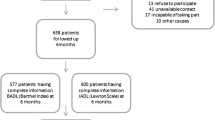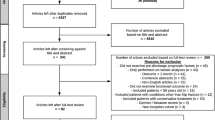Abstract
Background and aims
Executed studies did not clearly identify which index of comorbidity was an independent outcome determinant. The aim of this prospective observational cohort study was to address this issue.
Methods
We analyzed 200 consecutive patients with hip fracture. All patients underwent rehabilitation. At admission comorbidity was assessed through the cumulative severity, severity index, and comorbidity index of the Cumulative Illness Rating Scale. Discharge scores and effectiveness in the Functional Independence Measure motor subscale, and discharge destination were the outcome measures. Multivariate regression analyses were performed to identify determinants of outcome.
Results
Mini Mental State Examination and comorbidity index of the Cumulative Illness Rating Scale were important independent determinants of final (respectively, β = 0.46 and −0.25) and effectiveness (respectively, β = 0.47 and −0.25) in motor Functional Independence Measure scores, while hip strength and Rankin score were determinants of final motor Functional Independence Measure score (respectively, β = 0.21 and −0.20). Comorbidity index of the Cumulative Illness Rating Scale (odds ratio 8.18 for ≥3 versus < 3 comorbidity score; 95% confidence interval, 1.03–64.7) and Geriatric Depression Scale (odds ratio 4.02 for ≥6 versus ≤5 depression scale score; 95% confidence interval, 1.52–10.63) were risk indicators for nursing home.
Conclusions
Among the indices of the Cumulative Illness Rating Scale, comorbidity index is the sole independent determinant of both motor Functional Independence Measure scores and discharge destination in hip fracture patients. This suggests to specifically evaluate this index to identify the patients who may be admitted to a rehabilitation program.
Similar content being viewed by others
References
Zuckerman JD, Fabian DR, Aharanoff G, Koval KJ, Frankel VH (1993) Enhancing independence in the older hip fracture patient. Geriatrics 48:76–78, 81
Koren-Hakim T, Weiss A, Hershkovitz A et al (2012) The relationship between nutritional status of hip fracture operated elderly patients and their functioning, comorbidity and outcome. Clin Nutr 31:917–921
Feng L, Scherer SC, Tan BY, Chan G, Fong NP, Ng TP (2010) Comorbid cognitive impairment and depression is a significant predictor of poor outcomes in hip fracture rehabilitation. Int Psychogeriatr 22:246–253
Mathew RO, Hsu WH, Young Y (2013) Effect of comorbidity on functional recovery after hip fracture in the elderly. Am J Phys Med Rehabil 92:686–696
Parmelee PA, Thuras PD, Katz IR, Lawton MP (1995) Validation of the Cumulative Illness Rating Scale in a geriatric residential population. J Am Geriatr Soc 43:130–137
Cummings JL (1997) The neuropsychiatric inventory: assessing psychopathology in dementia patients. Neurology 48(5 Suppl 6):S10–S16
Granger CV, Cotter AC, Hamilton BB, Fiedler RC (1993) Functional assessment: a study of persons after stroke. Arch Phys Med Rehabil 74:133–138
van Swieten JC, Koudstaal PJ, Visser MC, Schouten HJ, van Gijn J (1988) Interobserver agreement for the assessment of handicap in stroke patients. Stroke 19:604–607
Folstein MF, Folstein SE, McHugh PR (1975) “Mini-mental state”. A practical method for grading the cognitive state of patients for the clinician. J Psychiatr Res 12:189–198
Sheikh JI, Yesavage JA, Brooks JO 3rd, Friedman L, Gratzinger P, Hill RD, Zadeik A, Crook T (1991) Proposed factor structure of the Geriatric Depression Scale. Int Psychogeriatr 3:23–28
Miller DW, Hahn JF (1996) General methods of clinical examination. In: Youmans JR (ed). Neurological surgery, ed 4. W.B. Saunders Philapdelphia, pp 31–32
Shah S, Vanclay F, Cooper B (1990) Efficiency, effectiveness and duration of stroke rehabilitation. Stroke 21:241–246
Kristensen MT (2011) Factors affecting functional prognosis of patients with hip fracture. Eur J Phys Rehabil Med 47:257–264
Di Giorgio L, Sodano L, Touloupakis G, Piciocco P, Attala D, Villani C (2012) Proximal femur fractures in elderly patients: the influence of comorbidity on prognosis in the short, medium and long term. Clin Ter 163:95–99
Bernardini B, Meinecke C, Pagani M et al (1995) Comorbidity and adverse clinical events in the rehabilitation of older adults after hip fracture. J Am Geriatr Soc 43:894–898
Patrick L, Knoefel F, Gaskowski P, Rexroth D (2001) Medical comorbidity and rehabilitation efficiency in geriatric inpatients. J Am Geriatr Soc 49:1471–1477
Press Y, Grinshpun Y, Berzak A, Friger M, Clarfield AM (2007) The effect of co-morbidity on the rehabilitation process in elderly patients after hip fracture. Arch Gerontol Geriatr 45:281–294
Chiu KY, Pun WK, Luk KD, Chow SP (1992) A prospective study on hip fractures in patients with previous cerebrovascular accidents. Injury 23:297–299
Langhorne P, Stott DJ, Robertson L et al (2000) Medical complications after stroke: a multicenter study. Stroke 31:1223–1229
Guerini F, Frisoni GB, Morghen S, Speciale S, Bellelli G, Trabucchi M (2010) Clinical instability as a predictor of negative outcomes among elderly patients admitted to a rehabilitation ward. J Am Med Dir Assoc 11:443–448
Jamal Sepah Y, Umer M, Khan A, Ullah Khan Niazi A (2010) Functional outcome, mortality and in-hospital complications of operative treatment in elderly patients with hip fractures in the developing world. Int Orthop 34:431–435
Shebubakar L, Hutagalung E, Sapardan S, Sutrisna B (2009) Effects of older age and multiple comorbidities on functional outcome after partial hip replacement surgery for hip fractures. Acta Med Indones 41:195–199
Pautex S, Jacques MC, Sant A, Herrmann F, Chevalley T (2005) A short comprehensive assessment to predict outcome of elderly patients after hip fracture. Aging Clin Exp Res 17:116–120
Titler M, Dochterman J, Xie XJ et al (2006) Nursing interventions and other factors associated with discharge disposition in older patients after hip fractures. Nurs Res 55:231–242
Becker C, Gebhard F, Fleischer S et al (2003) Prediction of mortality, mobility and admission to long-term care after hip fractures. Unfallchirurg 106:32–38
Thorngren KG, Ceder L, Svensson K (1993) Predicting results of rehabilitation after hip fracture. A ten-year follow-up study. Clin Orthop Relat Res (287):76–81
Ottenbacher KJ, Linn RT, Smith PM, Illig SB, Mancuso M, Granger CV (2004) Comparison of logistic regression and neural network analysis applied to predicting living setting after hip fracture. Ann Epidemiol 14:551–559
Ishida Y (2004) Mortality and functional outcome of hip fractures in the elderly. Clin Calcium 14:408–417
Lenze EJ, Munin MC, Dew MA et al (2004) Adverse effects of depression and cognitive impairment on rehabilitation participation and recovery from hip fracture. Int J Geriatr Psychiatry 19:472–478
Kos N, Burger H, Vidmar G (2011) Mobility and functional outcomes after femoral neck fracture surgery in elderly patients: a comparison between hemiarthroplasty and internal fixation. Disabil Rehabil 33:2264–2271
Acknowledgements
The authors thank Rosemary Allpress for English revision of the manuscript.
Author information
Authors and Affiliations
Corresponding author
Ethics declarations
Conflict of interest
The authors declare that they have no conflict of interest.
Funding
The research was not supported by Pharmaceutical Companies, but by institutional funding.
Ethical approval
The Technical Scientific Committee of our Institute approved the study protocol. The study was conducted in accordance with the principles of the Declaration of Helsinki.
Informed consent
All patients gave their written informed consent to participate.
Electronic supplementary material
Below is the link to the electronic supplementary material.
Rights and permissions
About this article
Cite this article
Gialanella, B., Prometti, P., Monguzzi, V. et al. Determinants of functional outcome in hip fracture: the role of comorbidity. Aging Clin Exp Res 30, 643–650 (2018). https://doi.org/10.1007/s40520-017-0812-x
Received:
Accepted:
Published:
Issue Date:
DOI: https://doi.org/10.1007/s40520-017-0812-x




